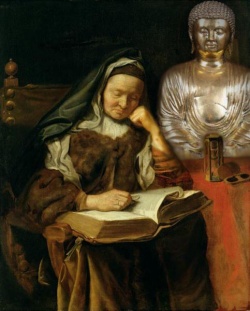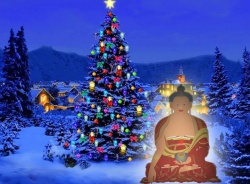Difference between revisions of "Activism and Mind Training"
(Created page with " Activism and Mind Training two dancers, one with fist, one in shock Gampo Abbey When the world is filled with evil, transform all mishaps into the [...") |
|||
| (3 intermediate revisions by the same user not shown) | |||
| Line 1: | Line 1: | ||
| − | + | <nomobile>{{DisplayImages|3818|3477|2558}}</nomobile> | |
| − | + | ||
| + | Activism and [[Mind Training]] | ||
| + | |||
When the [[world]] is filled with [[evil]], [[transform]] all mishaps into the [[path]] of [[bodhi]]. | When the [[world]] is filled with [[evil]], [[transform]] all mishaps into the [[path]] of [[bodhi]]. | ||
| − | This | + | This [[lojong]] slogan] has various translations. I have trouble myself with the [[word]] [[evil]]. But I think the translations all use the [[word]]. What it's getting at is when you find your [[life]] situation is causing enormous [[pain]] —or even slight [[pain]]— it's causing discomfort, not hiding from that, not running from that, in the usual ways we do. |
Instead, let it [[transform]] you into the [[path]] of [[bodhi]], the [[path of awakening]]. Let it wake you up. | Instead, let it [[transform]] you into the [[path]] of [[bodhi]], the [[path of awakening]]. Let it wake you up. | ||
| Line 35: | Line 37: | ||
This is [[pain]] which we may call [[anger]], [[pain]] we may call "rejection," [[pain]] we may call everything going wrong, [[stress]], We call it a lot of things but if you actually sit down and go into it, you usually find a {{Wiki|physically}} felt thing. Then you get as close as you can. | This is [[pain]] which we may call [[anger]], [[pain]] we may call "rejection," [[pain]] we may call everything going wrong, [[stress]], We call it a lot of things but if you actually sit down and go into it, you usually find a {{Wiki|physically}} felt thing. Then you get as close as you can. | ||
| − | This is the [[pith]] of [[transforming]] unfavorable circumstances into the [[path of awakening]], or letting the unfavorable circumstance [[transform]] you. [[People]] will often say "What does this have to do with the fact that [[people]] are living on the streets, [[people]] live [[lives]] where they are surrounded by [[violence]], where they have no safety, no [[protection]]. I want to do something to help this situation. I don't want to just sit on my red or black or brown or whatever colored cushion and get in {{Wiki|touch}} with MY [[pain]]." | + | This is the [[pith]] of [[transforming]] unfavorable circumstances into the [[path of awakening]], or letting the unfavorable circumstance [[transform]] you. [[People]] will often say "What does this have to do with the fact that [[people]] are living on the streets, [[people]] live [[lives]] where they are surrounded by [[violence]], where they have no safety, no [[protection]]. I want to do something to help this situation. I don't want to just sit on my [[red]] or black or brown or whatever colored cushion and get in {{Wiki|touch}} with MY [[pain]]." |
The point here is that effective [[action]] starts with [[self-knowing]], self-understanding of where we're caught. | The point here is that effective [[action]] starts with [[self-knowing]], self-understanding of where we're caught. | ||
| Line 55: | Line 57: | ||
[http://old-shambhala.shambhala.org/teachers/pema/lojong2.php] | [http://old-shambhala.shambhala.org/teachers/pema/lojong2.php] | ||
[[Category:Lojong]] | [[Category:Lojong]] | ||
| + | [[Category:Mind]] | ||
Latest revision as of 00:24, 14 January 2020
Activism and Mind Training
When the world is filled with evil, transform all mishaps into the path of bodhi.
This lojong slogan] has various translations. I have trouble myself with the word evil. But I think the translations all use the word. What it's getting at is when you find your life situation is causing enormous pain —or even slight pain— it's causing discomfort, not hiding from that, not running from that, in the usual ways we do.
Instead, let it transform you into the path of bodhi, the path of awakening. Let it wake you up.
I imagine on any average day of your life, you have a few you have of these painful emotions, outward situations that cause you to feel a lot of distress, emotional intensity of some kind. Then what is the suggestion? It says, Let it transform you.
First thing is taking the attitude of being curious about what's happening. In other words when there is pain, becoming curious. Just that, letting there be kind of a pause before the chain reaction begins.
Acknowledging Last week I talked about acknowledging being such a powerful tool. Acknowledging what's happening. You just acknowledge that pain is happening. Sometimes people will use different words they'll say, "My conditioning is kicking in here," or "My usual habits are being triggered here." You don't have to use fancy language. You can just acknowledge that you're feeling pain.
When you're sitting each day, instead of feeling the sitting is a time to chill out and forget about all that- particularly if it's got you in its grips, but little ones are also good to work with because they're not so overwhelming. When you sit down, first thing is you have to train in this extremely difficult and revolutionary advice to just let the words about it go, to let the words about it go, letting the thinking go, the story line. That is the basic instruction. It's not easy to do this. To sit and purposely churn it up a little bit. This is the contemplative part with your sitting practice this particular day- it may wind up being every day- you think about what's bothering you. To get in touch with the clenched quality of it, the sorrow, the grief, the loneliness.
What this is leading to is that first just acknowledge that something feels like a lump in your heart, or your throat, or your stomach, as is the energy if hot and molten, blocked and not moving, hard, but in any case pain, just pain.
Just start getting in touch with your body, find it in your body, find your unhappiness, your pain in your body. Usually we have places where we hold. It's valuable instruction to soften your belly because there is a lot of tension holding there. Just get in touch with it and breathe in and out where the tightness is.
You're trying to get close to it in an experiential way that's not just talking about it to yourself. Anything to get you away from the description of what's going on, who's to blame. Really being fully with the pain. This is somehow part of the pith of lojong is a whole different approach to being with pain, using it as an aid to awakening.
In order to use it as an aid to awakening you have to know it. We just feel this uncomfortableness and then there's a lot of mentally running away. Everything from dissociating so you're actually not there, which is involuntary and there's not a lot you can do about it except notice that you're dissociating. I'm not saying that you're supposed to do a specific thing, except that in your own way, in the way you're capable at that time, just acknowledging what's happening with an attitude of kindness. You can call it an attitude of self-compassion. That doesn't have to have any words to it. It's just a gentle approach to acknowledging that there's pain.
If it's possible to feel it, and the reason I'm stressing it is rather than think about it, you're going to think about it. The stories are going to blossom like a garden going wild, seeds popping out all over the place, flowering with your resentful thoughts, your how I'm going to get even thoughts, how you're going to make it all OK, that's my favorite, that's what I do. Or how I'm not going to do it this time. Whatever. As best you can, let the words go and really feel it as a way of knowing pain in a non-verbal way. Even if it's just for half a second.
If that's all you do, that is revolutionary right there. The heart of lojong is just taking a different attitude towards pain is something that can transform us rather than something we harden around, something that we protect against, we push away, and then the whole ego structure is really based on trying to get away from that pain.
It's kind of fear-based. I gave a teaching in Berkeley over Labor Day just on the subject of fear and I'll just say very briefly here what I taught that whole weekend is if you begin to find the pain, there is fear in it, it's the tension of pushing away, the hardness that you'll find there.
Someone said to me once, "Find the fear." I think the idea was that I was supposed to look and look and I wouldn't find anything. I came back and I said, "I found it. It's this huge painful knot in my solar plexus. And it's undeniably there." Then the teacher said, "That's already the resistance to the pain." What you're experiencing as pain is already the resistance to fear, the clutching, so there are meditations that could be of benefit to you where you breathe in and out of the pain. It's a mindfulness practice for going into the heart of the pain.
This is pain which we may call anger, pain we may call "rejection," pain we may call everything going wrong, stress, We call it a lot of things but if you actually sit down and go into it, you usually find a physically felt thing. Then you get as close as you can.
This is the pith of transforming unfavorable circumstances into the path of awakening, or letting the unfavorable circumstance transform you. People will often say "What does this have to do with the fact that people are living on the streets, people live lives where they are surrounded by violence, where they have no safety, no protection. I want to do something to help this situation. I don't want to just sit on my red or black or brown or whatever colored cushion and get in touch with MY pain."
The point here is that effective action starts with self-knowing, self-understanding of where we're caught.
You don't want to start helping people out of your uptightness, out of your strong sense of you're going to get revenge. It escalates the aggression and even though you may have short term successes, somebody has been so provoked by your aggression that the retaliation comes back. The cycle of aggression continues... century after century after century.
This is sort of like the Buck stops here. If you want to be an activist to work with the suffering of the world, jump right in and when you find that you can't do it, it's over your head, because your own fear, your own aggression, your own resentment, then do this practice.
It's not like either/or. You may be able to jump into a situation and the limits of your open-mindedness may be very wide. But when you meet the limits of your open-mindedness, then all your conditioning, all your uptightness click in.
Then it's like shutting down. You can't help this person anymore. They become your opponent. They're the ones driving you crazy. When you start to do the work of working with the suffering of the world, you find again and again that you can't get it to work out right. It's just people loving people.
It isn't that they turn out the way You want them to, or that the whole situation turn upside down because of your efforts. This is where the selflessness comes in, by jumping right in and being honest about meeting the edge of your open-mindedness and you experience it as pain, as rage, as resentment, as loneliness, as feeling misunderstood. We don't have to be activists to do this practice. It happens right in your own kitchen, your own office, on the streets, on buses, all over. You have plenty of opportunity to feel pain and to feel that we're in unfavorable circumstance or a difficult place...
The traditional lojong instruction is to then breathe in for yourself with the recognition that this pain is globally experienced, experienced by all of humanity, all our brothers and sisters feel this. We are very unique in terms of our personal histories, our stories.
When you get this close to pain, that's universal. Everybody feels fear, anger. Different things may trigger for different people. Breathe out sending relief.


